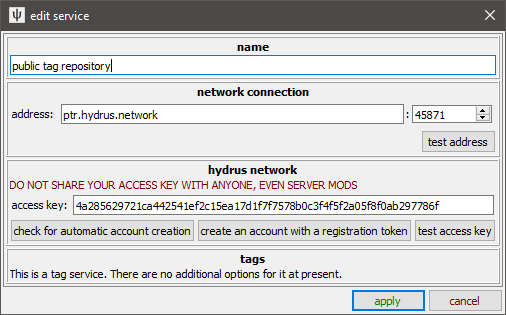PTR access keys¶
The PTR is now run by users with more bandwidth than I had to give, so the bandwidth limits are gone! If you would like to talk with the new management, please check the discord.
A guide and schema for the new PTR is here.
first off¶
I don't like it when programs I use connect anywhere without asking me, so I have purposely not pre-baked any default repositories into the client. You have to choose to connect yourself. The client will never connect anywhere until you tell it to.
For a long time, I ran the Public Tag Repository myself and was the lone janitor. It grew to 650 million tags, and siblings and parents were just getting complicated, and I no longer had the bandwidth or time it deserved. It is now run by users.
There also used to be just one user account that everyone shared. Everyone was essentially the same Anon, and all uploads were merged to that one ID. As the PTR became more popular, and more sophisticated and automatically generated content was being added, it became increasingly difficult for the janitors to separate good submissions from bad and undo large scale mistakes.
That old shared account is now a 'read-only' account. This account can only download--it cannot upload new tags or siblings/parents. Users who want to upload now generate their own individual accounts, which are still Anon, but separate, which helps janitors approve and deny uploaded petitions more accurately and efficiently.
I recommend using the shared read-only account, below, to start with, but if you decide you would like to upload, making your own account is easy--just click the 'check for automatic account creation' button in services->manage services, and you should be good. You can change your access key on an existing service--you don't need to delete and re-add or anything--and your client should quickly resync and recognise your new permissions.
privacy¶
I have tried very hard to ensure the PTR respects your privacy. Your account is a very barebones thing--all a server stores is a couple of random hexadecimal texts and which rows of content you uploaded, and even the memory of what you uploaded is deleted after a delay. The server obviously needs to be aware of your IP address to accept your network request, but it forgets it as soon as the job is done. Normal users are never told which accounts submitted any content, so the only privacy implications are against janitors or (more realistically, since the janitor UI is even more buggy and feature-poor than the hydrus front-end!) the server owner or anyone else with raw access to the server as it operates or its database files.
Most users should have very few worries about privacy. The general rule is that it is always healthy to use a VPN, but please check here for a full discussion and explanation of the anonymisation routine.
a note on resources¶
Danger
If your database files are stored on an HDD, or your SSD does not have at least 96GB of free space, do not add the PTR!
The PTR has been operating since 2011 and is now huge, more than two billion mappings! Your client will be downloading and indexing them all, which is currently (2021-06) about 6GB of bandwidth and 50GB of hard drive space. It will take hours of total processing time to catch up on all the years of submissions. Furthermore, because of mechanical drive latency, HDDs are too slow to process all the content in reasonable time. Syncing is only recommended if your hydrus db is on an SSD. It doesn't matter if you store your jpegs and webms and stuff on an external HDD; this is just your actual .db database files (normally in install_dir/db folder). Note also that it is healthier if the work is done in small pieces in the background, either during idle time or shutdown time, rather than trying to do it all at once. Just leave it to download and process on its own--it usually takes a couple of weeks to quietly catch up. If you happen to see it working, it will start as fast as 50,000 rows/s (with some bumps down to 1 rows/s as it commits data), and eventually it will slow, when fully synced, to 100-1,000 rows/s. You'll see tags appear on your files as processing continues, first on older, then all the way up to new files just uploaded a couple days ago. Once you are synced, the daily processing work to stay synced is usually just a few minutes. If you leave your client on all the time in the background, you'll likely never notice it.
easy setup¶
Hit help->add the public tag repository and you will all be set up.
manually¶
Hit services->manage services and click add->hydrus tag repository. You'll get a panel, fill it out like this:

Here's the info so you can copy it:
ptr.hydrus.network
45871
4a285629721ca442541ef2c15ea17d1f7f7578b0c3f4f5f2a05f8f0ab297786f
Note that because this is the public shared key, you can ignore the 'DO NOT SHARE' red text warning.
It is worth checking the 'test address' and 'test access key' buttons just to double-check your firewall and key are all correct. Notice the 'check for automatic account creation' button, for if and when you decide you want to contribute to the PTR.
Then you can check your PTR at any time under services->review services, under the 'remote' tab:
